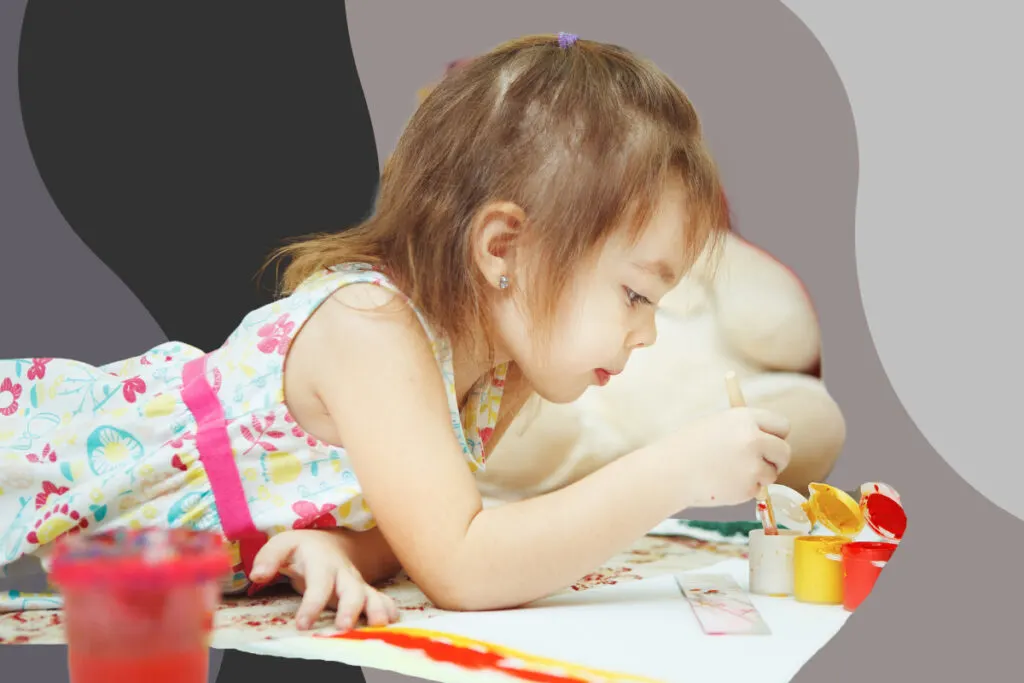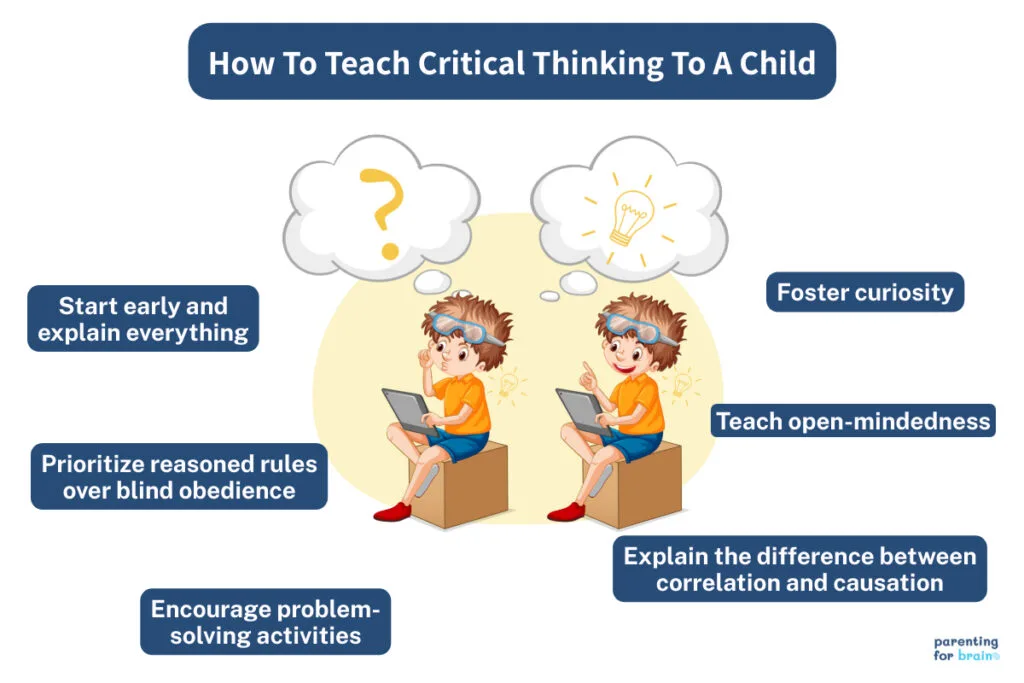Critical thinking is an essential cognitive process that involves actively analyzing, evaluating, and synthesizing information to form reasoned judgments and solve problems. John Dewey defined reflective thinking as the careful and deliberate determination of whether to accept, reject, or suspend judgment about a claim.
Critical thinking skills include conceptualization, analysis, evaluation, reasoning, synthesis, problem-solving, and openness to new ideas, fostering the ability to discern misinformation, eliminate bias, think independently, and make informed decisions. Thinking critically is vital for personal growth and career advancement. Find out how to develop and teach critical thinking to both adults and children.

TABLE OF CONTENTS
What is critical thinking?
Critical thinking is a set of skills and habits of mind to go beyond simply accepting information or ideas, but instead analyze the issue, evaluate information, and reason critically to make a conclusion or solve a problem. Thinking critically includes making creative connections between ideas from different disciplines.
American philosopher, psychologist, and educator John Dewey (1859–1952) called this “reflective thinking”. Dewey defined critical thinking as active, persistent, and careful consideration of a belief or supposed form of knowledge. It involves actively subjecting ideas to critical scrutiny rather than passively accepting their face value.1
What are critical thinking skills?
Here are 7 core critical thinking skills.
- Conceptualize: Form abstract ideas and mental models that accurately represent complex concepts.
- Analyze: Break down information into components and relationships to uncover patterns, principles, and deeper meanings.
- Evaluate: Assess the credibility, accuracy, quality, strength, methodologies, and relevance of claims or evidence using logical standards to judge the validity or significance of the information.
- Reason: Applying logical thinking to conclude from facts or evidence.
- Synthesize: Combining different ideas, findings, or information to form a coherent whole or a new perspective.
- Solve problems: Identifying solutions to issues through logical analysis and creative thinking.
- Open to other possibilities: Being willing to consider alternative solutions, ideas, or viewpoints beyond the initial scope.
Why is critical thinking important?
Critical thinking is an important part of cognitive development for the following 8 reasons.
- Discern misinformation: Critical thinking helps us separate facts from opinions, spot flawed arguments, and avoid falling for inaccurate information.
- Identify and eliminate prejudice: It allows us to recognize societal biases and close-mindedness.
- Think independently: It enables us to develop rational viewpoints rather than blindly accepting claims, mainstream narratives, or fads. It also helps children form their own opinions, make wise decisions, and resist peer pressure.
- Make good decisions: It enables logical thinking for better judgment and making rational decisions, not influenced by emotions.
- Communicate clearly: It lets us understand others’ perspectives and improve communication.
- Get better solutions: It broadens our thought process and enables good problem-solving to achieve the best solutions to challenges.
- Cultivate open-mindedness and creativity: It spurs intellectual curiosity to explore new paradigms.
- Grow skills set: It facilitates wiser, more informed choices that affect personal growth, career advancement, and positive relationships.
Why is critical thinking hard to teach?
Critical thinking is hard to teach because to think critically on a topic, deep knowledge about a subject is required to apply logic. Therefore, critical thinking skills are hard to teach by itself. The analytical reasoning skills learned on one topic don’t transfer quickly to another domain.2
What are examples of critical thinking?
Here are examples of critical thinking in real life.
- Solving a math problem: Breaking down complex math problems into smaller parts to understand and solve them step by step.
- Deciding on a book for a report: Reading summaries and reviews to select a book that fits the assignment criteria and personal interest.
- Resolving a dispute with a friend: Listening to each other’s perspectives, identifying the problem, and coming up with a fair solution together.
- Navigating social media safely: Assessing the credibility of online information and the safety of sharing personal data.
- Saving up for a toy: Comparing prices, setting a realistic goal, budgeting allowance money, and resisting impulse buys that derail the plan.
- Figuring out a new bike route: Studying maps for safe streets, estimating distances, choosing the most efficient way, and accounting for hills and traffic.
- Analyzing the motive of a storybook villain: Looking at their actions closely to infer their motivations and thinking through alternative perspectives.
How to develop critical thinking
To develop critical thinking, here are 10 ways to practice.
- Ask probing questions: Ask “why”, “how”, “what if” to deeply understand issues and reveal assumptions.
- Examine evidence objectively: Analyze information’s relevance, credibility, and adequacy.
- Consider different viewpoints: Think through other valid viewpoints that may differ from your own.
- Identify and challenge assumptions: Don’t just accept claims at face value.
- Analyze arguments: Break down arguments and claims into premises and conclusions, and look for logical fallacies.
- Apply reasoned analysis: Base conclusions on logical reasoning and evidence rather than emotion or anecdotes.
- Seek clarity: Ask for explanations of unfamiliar terms and avoid ambiguous claims.
- Discuss ideas: Share your ideas with others to gain insights and refine your thought processes.
- Debate respectfully: Engage in discussions with those who disagree thoughtfully and respectfully.
- Reflect on your thoughts and decisions: Question your thoughts and conclusions to avoid jumping to conclusions.

How to teach critical thinking to a child
To teach critical thinking to a child, encourage them to apply deeper thinking in any situation that requires decision-making in daily life. Here are 6 tips on teaching critical thinking.3–8
- Start early and explain everything: Young children often ask lots of questions. Instead of saying, “That’s how it’s supposed to be,” explain things to them as much as possible from an early age. When children are taught from a young age how to ask different types of questions and formulate judgments using objective evidence and logical analysis, they grow up confident in their ability to question assumptions and reason with logic rather than emotions. When you can’t answer specific questions, you can say, “That’s a good question, and I want to know the answer, too!”
- Prioritize reasoned rules over blind obedience: Authoritarian discipline stifles critical thinking, as demonstrated by psychologist Stanley Milgram’s 1963 study titled “Behavioral Study of Obedience.” In the study, most subjects, under authoritative orders, would administer electric shocks to a stranger and escalate to potentially lethal levels without questioning the authority. Avoid using “because I said so.” Encourage children to inquire, discuss, and participate in rule-making. Help them understand the reasons behind rules to foster critical thinking. Allow children to question and discuss the legitimacy of what we say.
- Encourage problem-solving activities: Encourage your child to solve puzzles, play strategy games, or take on complex problems to strengthen their analytical skills.
- Foster curiosity: Thinking critically means being willing to have your views challenged by new information and different perspectives. Curiosity drives children to explore and question the world around them, challenging assumptions and leading to a deeper understanding of complex concepts.
- Teach open-mindedness: Keeping an open mind and flexible thinking when approaching a new problem is essential in critical thinking. Suggest different points of view, alternative explanations, or solutions to problems. Encourage children to solve problems in new ways and connect different ideas from other domains to strengthen their analytical thinking skills.
- Explain the difference between correlation and causation: One of the biggest impediments to logical reasoning is the confusion between correlation and causation. When two things happen together, they are correlated, but it doesn’t necessarily mean one causes the other. We don’t know whether it’s causation or correlation unless we have more information to prove that.
References
- 1.Fisher A. Critical Thinking: An Introduction. Cambridge university press; 2011.
- 2.Willingham DT. Critical Thinking: Why Is It So Hard to Teach? Arts Education Policy Review. Published online March 2008:21-32. doi:10.3200/aepr.109.4.21-32
- 3.Quinn V. Critical Thinking in Young Minds. Routledge; 2018. doi:10.4324/9780429445323
- 4.Hess RD, McDevitt TM. Some Cognitive Consequences of Maternal Intervention Techniques: A Longitudinal Study. Child Development. Published online December 1984:2017. doi:10.2307/1129776
- 5.Slater M, Antley A, Davison A, et al. A Virtual Reprise of the Stanley Milgram Obedience Experiments. Rustichini A, ed. PLoS ONE. Published online December 20, 2006:e39. doi:10.1371/journal.pone.0000039
- 6.Rimiene V. Assessing and Developing Students’ Critical Thinking. Psychology Learning & Teaching. Published online March 2002:17-22. doi:10.2304/plat.2002.2.1.17
- 7.Dyche L, Epstein RM. Curiosity and medical education. Medical Education. Published online June 7, 2011:663-668. doi:10.1111/j.1365-2923.2011.03944.x
- 8.Schwartz S. The fallacy of the ecological fallacy: the potential misuse of a concept and the consequences. Am J Public Health. Published online May 1994:819-824. doi:10.2105/ajph.84.5.819
